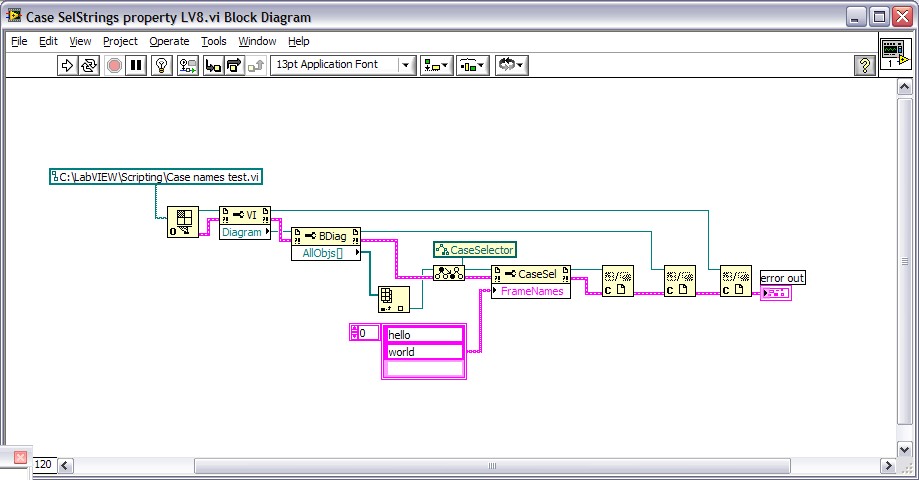-
Posts
6,217 -
Joined
-
Last visited
-
Days Won
120
Content Type
Profiles
Forums
Downloads
Gallery
Posts posted by Michael Aivaliotis
-
-
Well Folks,
Guess what, the seamless activation NI promissed us with this new Activation theme is not working that well for us! !@#!@#!@

We could not activate LV8.0 with our Software Lease....
Crap!
Ok, Last Update: After Trying On and Off for over 2 hours, it enventually worked. So may be we were trying to soon ?
PJM
It worked fine for me on the first try. I guess you already primed it for me huh? :thumbup:
I guess the drivers portion is not included with the download eh? It prompted me for it. BUT, this time, the installer doesn't abort the installation if the driver CD is missing. Unlike 7.1 which uninstalled everything if you didn't have the driver CD.
-
Thanks. I am only using three devices besides the USB-GPIB interface. In my program, they are addressed as GPIB0::16, GPIB0::18, and GPIB0::19 in the VISA constant.
Is there a way for you to verify that the VISA constant is populated with the values you assume are there in an EXE? I would make that contant a control and bring it up to the GUI. Build an EXE with it like this and then you know %100 that the VISA control has this populated properly.
-
I like your avatar. What did they call those things? curiously large rodents? Don't remember but it was funny. One of my many favorite movies.
Getting to the LLB stuff now. I would say ditch them... However it seems like your employer is stuck in the stone ages for some reason. I'm curious, do they use source code control? I bet not. Otherwise they would not be using LLB's. How can you do source code control on individual files when they're wrapped in an LLB.
Don't forget the dangers of LLB corruption! This is the biggest gotcha in LLB's. When VI's are saved into LLB's the file must be kept open and if there is a glitch during the save, the entire LLB is toast. There go all your VI's. NI support can fix this but who needs the hassle?
He's not dead, just mostly dead...
-
So LabVIEW disappears from the task manager in less than a second or does the vi window just close?
It removes the vi's from memory fast on my machine and closes those, but it seems like LabVIEW is trying to cleanup loose ends with the operating system after that.
So LV takes this time to close... so? What's the problem?
-
Maybe some of you have ran into this and know of a fix, because I am :headbang:
I am trying to figure out how to use datasocket without having the EXE wait ten seconds before it closes. For an easy test vi I just put a control on the front panel and set it up for datasocket in the control properties (subscribe, local system). If I run the vi and exit from LabVIEW, it takes LabVIEW about ten seconds to close (same with an EXE). I have tried setting the default setting for the datasocket as disabled and then enabling it in the vi and then disabling it before I exit. Same ten seconds. I even tried just opening a datasocket up and then closing it (datasocket primitives) with the same issue.
I am using 7.1.1 right now so I can't use the Shared Variables, plus I am needing to communicate with applications in LV 5.1.1 so that wouldn't work anyway. I could add some TCP-IP drivers to accomphish the data transfer, but I wanted to see if there is an easy solution before I started down that path.
Thanks for any input.
Have you tried running the close datasocket server VI?
-
I see you've been using OpenG Commander. In your attached llb, there are some missing strict-type controls. Can you re-save it with those?
-
No, I didn't like it for Burt Reynolds. I liked it as a movie in general. Yes the sex scenes were enjoyable, but the rest of the movie was great too. As far as my wife, actually her favorite part was the final scene. Her eyes were bulgingAnd let me guess, you liked it mainly because of Burtie boy's "surprisingly good performance" and not at all because of, oh, let's say, things like the topic or like Heather Graham's "scenes", right?Did your wife like it as much?

 while I was looking down trying to figure out what was wrong with me...
while I was looking down trying to figure out what was wrong with me...  hehe...
hehe...
-
Well I'll be a monkey's uncle!ok,the attachment is the strange BP vi.i delete the non-relative parts.i hope that's not a bug. good luck.

We have a bonafide bug...
-
Thanks for the contribution to the forums... this type of generosity makes me feel all warm and fuzzy inside...I have some VIs you can use to get you started. I also have a manual I could scan into a pdf for you. I'm attaching the VIs in the zip. These are currently being used here so they should work. They are rather old don't follow the device driver style usually used but it should get you started. Let me know if you want the manual scanned too.Download File:post-2473-1129065255.zip
-
This is fishy. If there is a breakpoint then LV will find it. Can you send the VI or a picture of it? I have a hard time believing this.Nothing ,LV can not find anything......
-
Interesting concept but impractical I think. Reducing complexity into a subvi is not a mechanical task isolated from its surroundings. It has to make sense. The VI must encapsulate specific functionality.We could do this in an analyzer version with scripting now. Another variant would be to count up the total number of nodes or structures or nesting level of structures, etc, etc, and then allow you to set alarm/warning level.PIE in the sky extra credit feature: after analysis, if certain thresholds are exceeded, then do a second analysis and suggest structures or groups of code to be converted into a subVI (do we have a subVI scripting function?) by the user. Present the suggestions in a table and highlight the currently selected group.
Now THAT would be useful.
-
If you start from scratch then it's totally unnecesary. You must have standards to confine your diagram size. If you don't then you're asking for diagram chaos. The standards should evolve based on screen hardware developments but they still should be in place.On another note here...How many of you are really finding the Navigation window to be a help in your own work? I'm not talking about refactoring someone else's work, but in initial development or maintenance of your own (or your team's) code?
-
-
I guess the NI based bot lost? The NI marketing folks are mourning...

-
I just want to make the GUI better on my VI.
And I realy want to use pictures innsted of normal "square" buttons from labview.
Is this possible?
Lots of good suggestions here. I would lean towards replacing the button images with imported *.png images (for transparency). Easy enough to do in the control editor.
-
You know what my pick is.
Burt, right? Actually, he had a surprisingly good performance in Boogie nights. I liked that movie.
-
Funny is a relative term. As for the joke, try looking up the relation between Jodie Foster and John Hinckley's attempt on president Reagan's life.
I see now... what a wack job! Hinckley's Obsession -- Jodie Foster
-
You took the words right out of my mouth. :thumbup:3. Use the OpenG INI read and write functions to load and store the clusters in INI sections and variables.
-
___________________________________________________________________________
Hmm... for some reason I feel like going out and shooting the american president. :ninja:
 Will this get the FBI on my back? I guess it's time to
Will this get the FBI on my back? I guess it's time to  and go into hiding.
and go into hiding.I don't get the joke... was this suppose to be funny?
-
As I am giving lectures on Coding Architecture in LabVIEW I've been collecting these gems.
Another example of "Extreme Data Flow Programming" this is aptly named "Run Away"

I hope you got paid by the wiring node...
-

 Congratulation!! :thumbup:
Congratulation!! :thumbup: 

-
It's Friday.. so here's something to kill those afternoon hours..
http://news.bbc.co.uk/1/shared/spl/hi/pop_...fest/html/1.stm
-Khalid
I think I'm secretly in love with Murata Boy
-
Well, "that country", at least to an extent, is part of the US, so I think you should be covered.
My bad. I'm still getting used to the fact that I'm in the US now. Since 3/4 of my family is still in Canada (I miss them very much), there's a strong pull in that direction...
As far as the LabVIEW domain in other countries, I think the biggest issue would be the LabVIEW trademark rights. NI's lawyers would love that. The laws pertaining to domain registration differ from country to country. Some countries require you to be a citizen of that country (for personal domains) or have a business that operates in that country. I know this is true for some (read the fine print).
-
Anyone ever consider registering a Virgin Islands domain name? ( LabVIEW.VI )?!

nice one :thumbup: However don't you need to have some affiliation with that country?





Monitoring and controlling multiple RT systems
in Real-Time
Posted
Since when? This is not true. NI's web server supports Mozilla browsers as well. Where did you get that information from?